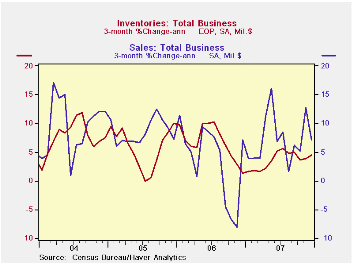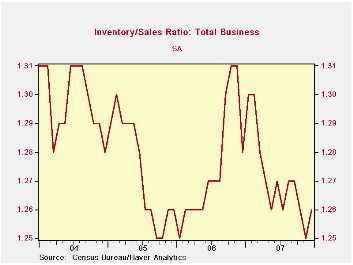 Global| Feb 14 2008
Global| Feb 14 2008U.S. Business Inventory Accumulation Down in 4Q Due To Autos
by:Tom Moeller
|in:Economy in Brief
Summary
The latest figures from the Commerce Department indicate that total business inventory accumulation in December of 0.6% followed a 0.4% November rise. The three month change in inventories of 4.5% (AR) was down from a 4.9% rate of [...]

The latest figures from the Commerce Department indicate that total business inventory accumulation in December of 0.6% followed a 0.4% November rise. The three month change in inventories of 4.5% (AR) was down from a 4.9% rate of accumulation during 3Q. The deceleration was not, however, quite as drastic as indicated by the 1.2 percentage point subtraction inventories made from economic growth, indicated in the advance read of 4Q GDP.
Retail inventories fell 0.1% during December following a revised 0.3% November decline. Inventories of motor vehicles fell 1.6% in December and the three month change swung to -8.2% (AR) from an 18.5% rate of accumulation during 3Q. Inventories excluding autos rose 0.7% in December (3.2% y/y) and the rate of accumulation last quarter nearly tripled that in 3Q. 
The acceleration was due to building materials which grew 0.3% in December but rose at a 6.8% rate in 4Q versus a 1.4% rate of decline during 3Q. Furniture inventories fell 0.5% (+4.8% y/y) after a 0.9% November drop and the three month change fell to 2.8% (AR) from 10.4% in 3Q. At clothing & accessory stores December inventories rose 0.5% after two months of modest decline. The three month rate held steady last quarter with 3Q at roughly unchanged. Inventories at general merchandise stores rose 0.9% in December and recouped about half of a November decline. For the quarter decumulation held steady with 3Q at a 2.5% rate.
Wholesale inventories jumped 1.1% after a 0.8% November surge. Petroleum inventories skyrocketed 9.2%, more than double the November rise. Less petroleum wholesale inventories rose 0.9% but the three month change fell to 5.3% (AR) from 7.4% during 3Q. During the last ten years there has been a 59% correlation between the annual change in wholesale inventories les petroleum and the change in merchandise imports.
Factory inventories increased 0.8% after a firm 0.7% rise during November. The three month growth in factory inventories accelerated to 6.7% from 2.5% during 3Q. Some of that acceleration owed to petroleum refineries, but excluding petroleum factory inventories still rose 5.8% (AR), nearly triple the 3Q rise.
Business sales fell 0.5% (+6.0% y/y) due to declines in wholesale sales and factory shipments. The decline lifted the ratio of inventories to sales off its lowest level since early 2006.
| Business Inventories | December | November | Y/Y | 2007 | 2006 | 2005 |
|---|---|---|---|---|---|---|
| Total | 0.6% | 0.4% | 4.0% | 4.0% | 5.8% | 6.2% |
| Retail | -0.1% | -0.3% | 2.9% | 2.9% | 3.2% | 2.8% |
| Retail excl. Autos | 0.7% | -0.4% | 3.2% | 3.2% | 4.5% | 4.5% |
| Wholesale | 1.1% | 0.8% | 6.1% | 6.1% | 8.5% | 7.4% |
| Manufacturing | 0.8% | 0.7% | 3.6% | 3.6% | 6.4% | 8.9% |
Tom Moeller
AuthorMore in Author Profile »Prior to joining Haver Analytics in 2000, Mr. Moeller worked as the Economist at Chancellor Capital Management from 1985 to 1999. There, he developed comprehensive economic forecasts and interpreted economic data for equity and fixed income portfolio managers. Also at Chancellor, Mr. Moeller worked as an equity analyst and was responsible for researching and rating companies in the economically sensitive automobile and housing industries for investment in Chancellor’s equity portfolio. Prior to joining Chancellor, Mr. Moeller was an Economist at Citibank from 1979 to 1984. He also analyzed pricing behavior in the metals industry for the Council on Wage and Price Stability in Washington, D.C. In 1999, Mr. Moeller received the award for most accurate forecast from the Forecasters' Club of New York. From 1990 to 1992 he was President of the New York Association for Business Economists. Mr. Moeller earned an M.B.A. in Finance from Fordham University, where he graduated in 1987. He holds a Bachelor of Arts in Economics from George Washington University.






